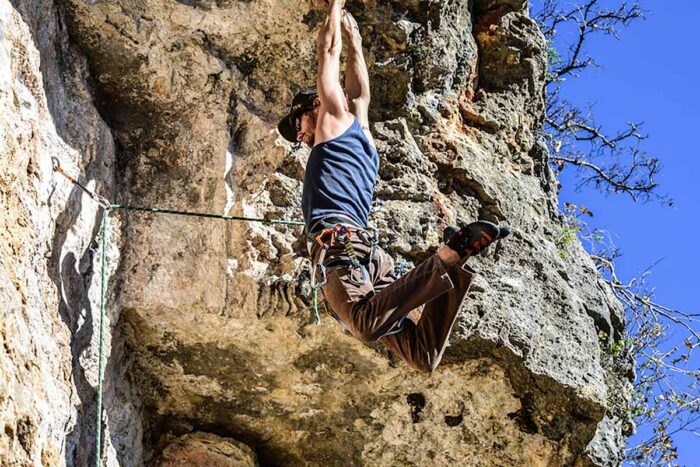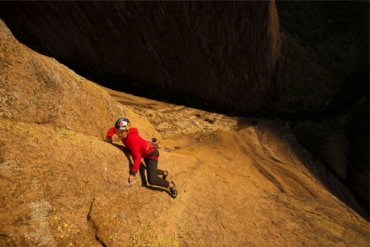Sport climbing outside can be intimidating.
It’s not comfortable to leave behind the controlled gym environment and the upward tug of the top rope in favor of leading a climb and clipping into the wall as you go. But just a few simple steps will get you feeling confident and stoked about everything sport climbing has to offer.
Editor’s note: This story details the experience of one climber. It does not provide specific recommendations on climbing techniques, anchor building, or rope management. To learn more detailed rock climbing techniques, consult a professional guide.

What Is Sport Climbing?
Sport climbing is defined by the anchoring hardware, which can be a sleeve bolt and a hanger or a glue-in bolt. These are placed by the first ascensionist, and the placement roughly defines the route’s intended path. These anchors are extremely reliable as long as they are well-maintained.
The sport climber leading a route protects themselves by clipping a quickdraw (two carabiners connected by a textile sling) to the bolt hanger, and then clipping their rope to the free carabiner before climbing further.

There are two types of sport climbing: lead climbing and top-roping. Lead climbing means the climber ascends as described above, clipping bolts as they progress up the route. The belayer controls the ground side of the rope, and if the climber falls, they will fall to the bolt, and then at least the same distance below it before the rope catches. This fall is called a “lead fall.”
In top-roping, the rope goes from the belayer to the top anchors of the sport route, and then down to the climber. As the climber ascends, the belayer takes up the slack on their side of the rope. With a proper belay, if the climber falls, they will not fall any significant distance, as they are supported by the rope from above.

Top-roping is much safer than lead climbing and is almost always the first step for a new outdoor climber. But in order to set up a top rope, a climber must lead the route to the top anchors or have access to these anchors from the top of the cliff.
How I Learned to Sport Climb Outdoors
I grew up visiting climbing gyms about once a year with my family, often climbing in tennis shoes. In college, I started gym climbing more regularly, mostly bouldering (climbing short walls above pads with no rope) and auto-belays (devices that let you climb up a wall, and then catch you and slowly let you down to the ground if you fall).
As my skill level and interest in rock climbing increased, I started getting the itch to do more. My coworkers at GearJunkie got me hooked on the idea of learning the (literal) ropes of sport climbing.
Sport climbing is a type of rock climbing that requires you to clip your rope into fixed bolts in the rock as you climb. It’s a common form of climbing and requires less gear than traditional climbing. The climber is belayed by a partner below and uses the fixed bolts for periodic protection along the route.
Because the climber is not on a top rope, falling is more consequential — they will fall beyond the previous bolt that was clipped. One of the biggest upsides of sport climbing is its accessibility. Many crags have sport climbing routes, and the setup is simple and quick.
My wife also enjoys climbing, so we both decided to learn how to sport climb so that we could be each other’s lifetime belay partners. Though it may seem simple and intuitive, here are the steps we took to enable us to confidently lead outdoor sport climbs with our own gear.
Get Comfortable on the Wall
First-time climbers shouldn’t jump straight to sport climbing. First, get comfortable climbing walls via top rope, auto-belay, or bouldering. A climbing gym is a perfect place to practice proper climbing techniques and develop the necessary strength and stamina to scale tall walls. Increase your skill level by attempting harder routes and watching others climb.
Sport climbing is more difficult and scary than climbing on top rope. You’ll want to build a solid climbing foundation before giving it a try. Plus, some climbing gyms require you to climb a 5.10 route on the first attempt before you can take a basic sport climbing course.

Take a Course at a Climbing Gym
Most climbing gyms have a plethora of courses available, from basic climbing techniques to Sport Climbing 101. At our local gym, we signed up for Sport Climbing Basics, a course that was offered regularly. It covered the gym’s entrance fee and any rental gear needed.
We loved our course. The instructor taught us common sport climbing terms and proper techniques for belaying, clipping quickdraws, falling, catching a fall, rope management, and more. Plus, he warned us of common mistakes and taught us how to avoid them.
At the end of the course, we were certified to sport climb in that gym so we could continue practicing our new skills. We even stayed after the class to keep practicing while the teaching was fresh in our minds.
Some sport climbing courses cover the basics for indoor sport climbing only, where you don’t have to place your own quickdraws and where there’s no need to clean your anchor. Other courses are more comprehensive and better prepare you for outdoor sport climbing on your own.
Ours was a simpler course, and instead of paying for the next course, we took our basic knowledge and went outdoor climbing with some experienced climber friends to round out our training.
Climb Outside With Friends or a Guide
My coworkers are avid climbers and jumped at the chance to hit the crag together. Because sport climbing outside is such a different experience, we first climbed while our skilled friends belayed us. Then, I belayed my wife while our friends watched closely and gave pointers.
The whole experience was a major confidence builder and left us feeling comfortable with climbing on lead in an outdoor setting. Plus, because our gym course didn’t cover cleaning a route, our friends thoroughly taught us the process and watched as we continually set and cleaned our anchors.
I’m not going to outline the intricacies of anchor building in this article because there are countless setups depending on the anchors available. To learn how to build anchors, I strongly recommend taking a guided course or learning from experts.

Another bonus was that this experience of climbing with friends fueled our stoke for sport climbing. We loved the freedom and the options that our new hobby offered and couldn’t wait to get our gear and head out on our own.
Be sure that the friends you go with are very knowledgeable and skilled before trusting them to help and teach you on the wall. If you don’t have any close climber friends, local climbing gyms are great places to meet belay partners or join group outings.
Buy Basic Sport Climbing Gear
Feeling comfortable and excited about our new sport climbing abilities, we were ready to accumulate our own gear. Climbing gear is expensive and, as beginners, we really only wanted the essentials. By this point, we both had climbing shoes, chalk bags, harnesses, and belay devices — we had become semi-regular gym rats before taking on sport climbing.

Beyond those items, we needed climbing rope, about 10 quickdraws, helmets, four locking carabiners, and two runners. Check out our beginner’s gear list here:
And be sure to check out GearJunkie’s guide to the best climbing ropes, shoes, harnesses, and helmets.
Climb Outside With Friends to Test Your Gear
Finally, we had the gear and were ready to test it out. We once again called upon our climber friends and set up a time to hit the crag.
This time, with the supervision of our friends, my wife and I used only our own gear to climb together. This helped us ensure that our climbing kit was what we needed to safely climb on our own. At the recommendation of our friends, we ended up grabbing a few more locking carabiners and runners after our outing.
By the end of the day, my wife and I were sport climbing on our own and with our own gear. Our friends were nearby and had watched us for most of the day, checking our knots, watching us set and clean our anchors, inspecting our gear, and observing us belay and climb. This outing again boosted our confidence, and we left knowing that we could now hit the crag by ourselves and climb safely with our own gear.

Find a Crag and Climb On!
A few weeks later, my wife and I traveled and found a nearby sport crag on the Mountain Project app. We gathered our gear, found the wall, set up and inspected everything, and talked through our sport climbing process. Once comfortable, we started climbing and had an absolute blast.
There are a few different ways to find nearby climbing crags. You can call your local climbing gym and ask for suggestions, you can download and use the Mountain Project app, or you can hire a climbing guide for the area.

Sport climbing opens up a ton of possibilities and adventure opportunities. Now, when my wife and I get the urge to climb, we don’t have to find a climbing gym and pay entrance fees. We can simply show up at a crag, unload our gear, and climb on.
If that freedom sounds good to you, and if you feel stagnant in your current climbing ability, give sport climbing a try. Once you learn it and accumulate the gear, it’s a hobby that’s mostly free, accessible, and downright fun.
FAQ
Is sport climbing safer than bouldering?
In bouldering, climbers are usually no more than 10 feet above the ground. The risk of minor injuries in bouldering is very high, but dying while bouldering is very unlikely. In sport climbing, serious injury or death is possible, but overall, sport climbing sees fewer accidents compared to many other outdoor sports. Serious injuries are usually the result of mistakes from belayers or rope management.
Is sport climbing the same thing as trad climbing?
No, sport climbing and trad (traditional) climbing involve different sets of skills and difficulty levels. In sport climbing, a route developer drills into the rock to create protection in the form of bolts and hangers on the route for all future climbers.
In trad climbing, climbers insert removable gear into cracks or crevices in the wall, resulting in protection that can be less reliable than in sport climbing. In general, trad climbing requires more experience and training than sport climbing.
Is sport climbing safer than trad climbing?
Generally, sport climbing is safer than trad climbing because of the more reliable protection from bolts anchored directly into the rock. While the cams, nuts, and other equipment of trad climbing can also offer protection, that process is usually less reliable than the bolts and quickdraws used by sport climbers. The degree of safety in trad climbing is determined by the climber inserting gear rather than someone who bolted a route for other climbers to follow.







